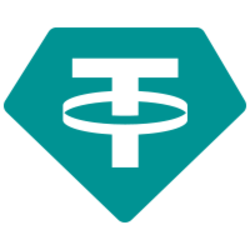Tether Price
USDT
How Much is 1 Tether (USDT)
Convert USDT to your currency
Last Updated on Dec 22, 2025 10:12 AM
What is Tether?
About the coin
Tether (USDT) is a cryptocurrency that aims to maintain a stable value by pegging itself to the U.S. dollar. It was created to offer a stable alternative to the volatile nature of other cryptocurrencies. Tether is the most popular stablecoin and is widely used as a digital dollar substitute on many exchanges.
Main features
Tether is designed to convert cash into digital currency, anchoring its value to national currencies like the US dollar, Euro, and Yen. It is claimed to be 100% backed by USD reserves, providing stability in the crypto space. Tether is issued by Tether Limited, a company incorporated in Hong Kong and governed by the laws of the British Virgin Islands.
How it works
Tether can be used on exchanges like Poloniex or Bittrex to purchase Bitcoin and other cryptocurrencies. It can be transferred to any Omni Layer enabled wallet without transaction fees, although external wallets and exchanges may charge fees. Users can convert USDT to USD through the Tether.to Platform, which also allows conversion between USD and bank accounts. Tether provides a way to move fiat in and out of exchanges quickly and cheaply, circumventing the rocky relationships exchanges often have with banks.
Wallet for Tether
Experience the future of Crypto Wallets with Tangem
Tangem supports networks for Tether
- Ethereum
- Solana
- Tron
- Avalanche
- Ton
- Aptos
- Kava
- Shibarium
Metrics
Insights
Price performance
Another
Tether FAQ
- Tether is a blockchain-based digital asset used for transferring value and interacting with decentralized applications. It operates without central control, relying on distributed network technology.
- Key features include scalability, low fees, and fast processing. Tether supports developers and users who need a flexible blockchain environment.
- USDT represents the same asset as Tether. The ticker is simply a short label for trading and listing purposes.
- You can buy Tether using on-ramp services available in Tangem Wallet or exchanges. After purchasing on an exchange, you can transfer it to your Tangem Wallet.
- The safest option is to use a hardware wallet that keeps your private keys offline. Tangem provides secure cold storage protection.
- Every Tether token is 100% backed by Reserves, which includes traditional currency, cash equivalents, and other assets, including receivables from loans made by Tether to third parties.
How to secure Tether with Tangem Wallet?
Tangem products are for everyone, from beginners to experts. They keep your crypto safe and easy to manage. With cutting-edge technology, Tangem lets you control and protect your digital assets.
Get TangemGet the Tangem Wallet and take control of your assets with just one tap. It's perfect for anyone new to crypto and offers a great experience for more experienced users too.
Sync Tangem Wallet with our App. During the activation process, the card’s embedded chip generates a random private key, ensuring that the wallet cannot be compromised.
Discover the power of crypto. Manage crypto with balance tracking, secure transactions, and direct purchases or swaps through Tangem Wallet.
Why choose Tether wallet with Tangem.
Private. No registration and KYC required to use the app. We don't track your data.
Secure. Your private keys are encrypted and never leave your device. Only you have control over your funds.
Innovative Design Options. Choose from a variety of elegant designs, including unique co-branded editions and our innovative ring-form factor wallet, ensuring both style and functionality.
24/7 Online Support. Fast support for your needs. Live chat and email support for customers from all over the globe.
Other crypto assets supported in Tangem Wallet.
Stay connected.
Don’t miss out on our progress and latest updates. Have an impact — join our community today!

🎉 You've unlocked 15% OFF!
Use 15OFFRING — valid for Tangem Ring till 30/09/2025 | Tap & Get